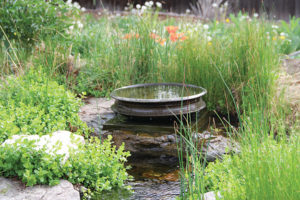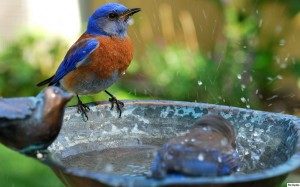Every garden can benefit from a water feature. From still reflecting pools to vibrant fountains, water adds an important element to our outdoor spaces. Water also brings life to a garden, figuratively, as well as literally. So in deciding how we want to incorporate water into our spaces, let’s look at several considerations.
Purpose
 Water can perform many functions in a garden from serving as a focal point to attracting wildlife or creating white noise to cover other unwanted sounds. A well designed water feature may possibly perform many of these functions at the same time, but it is important to know what you are trying to accomplish before you get started.
Water can perform many functions in a garden from serving as a focal point to attracting wildlife or creating white noise to cover other unwanted sounds. A well designed water feature may possibly perform many of these functions at the same time, but it is important to know what you are trying to accomplish before you get started.
Still water
From modest bird baths to larger reflecting pools, still water encourages relaxation and contemplation. As in any design, simple can also be quite beautiful. A tasteful bird bath placed in a lush garden is likely to be much more successful than a waterfall built from a kit or placed in an unnatural location on a site. Pools built in geometric shapes such as squares, rectangles, and circles look man-made but intentional, and can fit well in many different landscapes.
Moving water
Moving water brings energy to a garden, and the more the water moves, the more energy it creates. Moving water also creates noise. This can vary from a soothing babble to a rushing torrent. Be careful with both the energy level and the noise when creating a water feature in your garden because after a while either level can become tiresome.
Gardening for wildlife
 All living things need water, so if you are gardening for wildlife it makes sense to include water in your landscape, and to do it in a way that makes the water accessible.
All living things need water, so if you are gardening for wildlife it makes sense to include water in your landscape, and to do it in a way that makes the water accessible.
Birds and insects such as dragonflies can access most water features, but in general, a shallow water feature on the ground, such as a large carved out stone or a low basin will be accessible to more animals. Turtles, amphibians, and smaller mammals will all benefit from this easy access. A few stones, or perches placed in water also encourages access. Just remember to clean the water every few days in the summer to discourage mosquitoes.
At our last house we had a simple statue pouring water into a shallow bowl set at ground level. There were several large rhododendrons set as a backdrop to the statue and there was a large hickory tree nearby. Most of the time the fountain was turned off, but when we were in the yard we would turn it on and the garden would come alive.
I believe the birds in the area knew where our fountain was, and would visit it often, but it seemed they could not resist themselves when they heard the faint murmur of moving water. It was a real joy to see cardinals and chickadees drop out of the trees and splash around under the stream of water.
Water in winter
Wildlife needs access to water at all times of year. If you do include a water feature for wildlife, consider purchasing a simple heater for the winter months. These heaters do not actually warm the water, they just keep it from freezing, so it is still accessible to overwintering birds and animals. These areas of your garden with open water can become alive with activity after a snowstorm or during long cold snaps and can really brighten a dreary winter day.
Maintenance
As with any part of a garden, water features require maintenance. Water in small birdbaths or basins can be replaced every couple days in summer, but larger features will need a pump to recirculate the water in order to keep it healthy. Pumps are usually removed and brought indoors during winter months to protect them from damage due to freezing. This is another reason why it is often a good idea to keep things simple when it comes to water gardens.
Adding water brings a new dimension to every landscape. Start with a birdbath or basin and see how your garden comes alive, or bring in professionals for more extensive projects such as fountains and pools. You will be glad you did.


